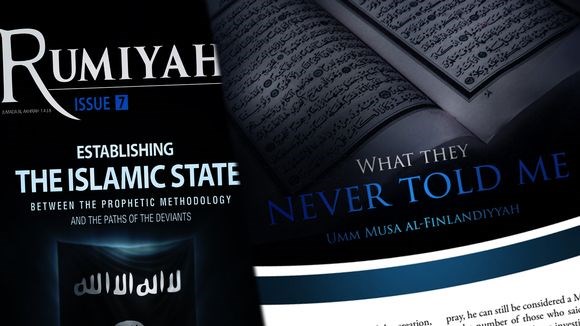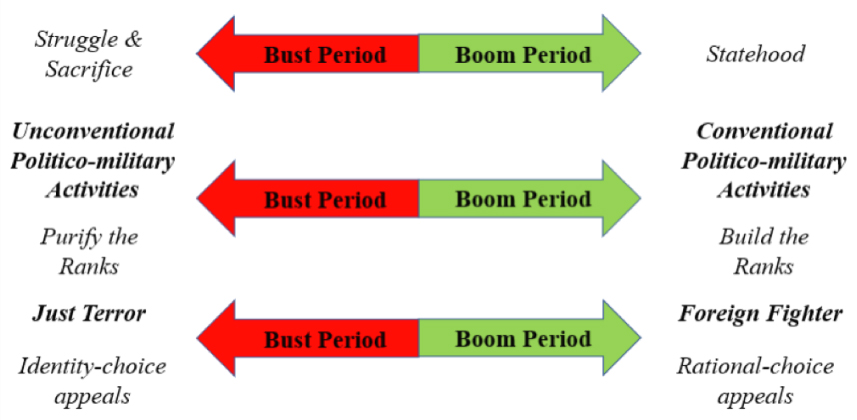By Haroro J. Ingram & Alastair Reed
In Part I of this series, the authors presented the key findings of the CTSC Project’s latest publication titled “Islamic State’s English-language Magazines, 2014-17: Trends & Implications for CT-CVE Strategic Communications”. It began by highlighting the limitations inherent to studies of ISIS’s English language messaging before identifying the first of three key trends in the narratives, themes and propaganda strategies deployed in ISIS English-language magazines and its implications for CT-CVE practitioners. Part II explores the remaining two trends and considers the lessons for CT-CVE strategic communications.
Trend 2: Over the period of 2014-17, ISIS’s propagandists appeared to deploy a “hedging” strategy whereby certain messaging themes were prioritized over others during periods of boom (circa. 2014-15) versus bust (circa. 2016-17).
As Figure 2 illustrates, ISIS propaganda tended to emphasise certain themes over others dependent on the strategic circumstances at the time. During its period of relative boom between 2014 and 2015, ISIS’s messaging in Islamic State News, Islamic State Report and early issues of Dabiq tended to focus on themes of statehood, conventional politico-military activities, calls to “build the ranks” with foreign fighters and rational-choice appeals. In contrast, as its fortunes waned, messaging in later issues of Dabiq and throughout Rumiyah tended to emphasise struggle and sacrifice, unconventional politico-military activity, calls to “purify the ranks”, encouragement to engage in “Just Terror” and identity-choice appeals. What is important to note, however, is that bust themes did not completely disappear during periods of boom and vice versa. By deploying a “hedging” strategy, ISIS was able to pivot its messaging campaign as strategic conditions changed.
Implications for Practitioners: In recognizing the signatures of ISIS’s “hedging” strategy, CT-CVE strategic communications practitioners will be better positioned to shape their campaign and message design to pre-empt ISIS’s strategic pivots in both the information and politico-military theatres.
Perhaps the most significant implication of this trend for practitioners is the need to devise a simple overarching narrative to cohere their CT-CVE messaging campaign rather than a suite of themes. After all, a narrative-based approach to campaign design allows for flexibility in message design as strategic conditions change. For example, a simple overarching narrative – such as “violent extremists cause and exacerbate crises while the government/civil society seek to solve them” – allows for great scope and flexibility of messaging. In contrast, a thematic-based approach that coheres a communications strategy around a handful of intuitively selected themes risks being only fleetingly pertinent and ill-equipped to pivot as conditions change.
Trend 3: The role of ISIS’s English-language magazines must be understood within the context of its entire propaganda effort.
ISIS’s English-language magazines represent a very specific format (i.e. magazines), disseminated on a specific medium (i.e. online), targeting a certain audience (i.e. English-speaking Muslims, predominantly living in the West) with long form messages (i.e. each issue is several dozen pages in length) disseminated periodically (e.g. monthly, quarterly). This underscores the inherent limitations of using any one type of ISIS propaganda to inform analyses given the extraordinary diversity of formats and mediums used by ISIS to disseminate both long and short form messages. Placed into its broader context, ISIS appears to deploy long-form messages like its English-language magazines as a means to augment a campaign approach that is largely dominated by short-form messages (e.g. photo reports and short audio-visual releases). It is an approach that seems to use waves of short form messages to prime its audiences for periodically released long form messages. Whether this is intuitive or strategic by ISIS is largely inconsequential, CT-CVE approaches need to take these dynamics into account at both campaign and message design levels.
Implications for Practitioners: The KISMI (Keep It Simple, Maximise Impact) approach to rolling-out a CT-CVE strategic communication campaign is characterized by messaging cycles dominated by PS-PS (Persuasive, Simple, Positive, Short) messages augmented by TANDEM (Thematically Accumulated, Narrative Driven, Emotion Motivators) messaging.
 Figure 3: Synchronising PS-PS and TANDEM messaging
Figure 3: Synchronising PS-PS and TANDEM messaging
Figure 3 illustrates the Keep It Simple Maximise Impact (KISMI) principle of rolling out a CT-CVE strategic communication campaign. It is based on the need for CT-CVE practitioners to take into account that those who are most susceptible to radicalization are, by definition, experiencing perceptions of crisis which can hinder their ability to activate deliberative thinking. This renders such individuals vulnerable to cognitive biases which has significant consequences for how information is processed and decisions are made. It is therefore necessary for CT-CVE messaging to prime such audiences with short simple messaging over a period of time prior to the dissemination of longer and more complex messages. The study describes the former as PS-PS messaging which stands for:
- Persuasive: the message is deployed with the intent of leveraging rational- or identity-choice decision-making in its audiences. In other words, messaging is deployed with persuasive intent and never for simply informational purposes.
- Simple: the message is direct and unambiguous and does not rely on its audiences engaging in complex deliberative considerations in order to achieve its intent.
- Positive: the message focuses on the benefits of certain rational- or identity-choice decisions. In contrast, negative messaging focuses on the detrimental impact of certain rational or identity choice decisions.
- Short: whether written, verbal or audiovisual, the message is brief in length.
While PS-PS messaging should dominate at message cycle (i.e. a designated period of message dissemination linked to a particular event or issue) and overall campaign levels, it should ideally be augmented by TANDEM messages. TANDEM stands for:
- Thematically Accumulated: the message brings together the key themes which featured in the PS-PS messaging that preceded it in the messaging cycle. Put another way, the PS-PS messaging acts as a primer for the fusion of themes that appear in the TANDEM message.
- Narrative Driven: the message ties together those aforementioned themes into a story. This narrative may use certain characters, issues or events to explore the relationship between those themes.
- Emotion Motivators: the message weaves emotion-based motivators pertinent to the target audience into its narrative.
The period of PS-PS is designed to prime audiences for the TANDEM messaging that is then proceeded by more PS-PS messaging to reinforce the aims of that particular messaging cycle. The cumulative impact of successive messaging cycles should be synchronized in such a way to achieve overarching campaign level objectives.
Current Gaps, Ongoing Challenges
The research described in this article sought to demonstrate the utility of drawing upon primary source materials as a means to “reverse engineer” lessons for CT-CVE strategic communications. To do so it was also necessary to highlight both the inherent limitations of drawing upon ISIS’s English-language magazines and the need to place these sources into its appropriate context. Indeed, despite a flood of research in recent years, there remain significant gaps in the scholarly field that are likely mirrored in strategic-policy circles. For example, far more research needs to be devoted to understanding the relationship between offline and online propaganda at both “supply” and “demand” ends. More broadly, the causal relationship between consumption of violent extremist propaganda and committing violent extremist acts is assumed but not yet properly understood. As such, when it comes to devising CT-CVE strategic communications we are often working partly in the dark. But even this is only part of the challenge. As violent extremist threats continue to evolve, it will be essential for the field to be ever wary of the biases that may skew the understanding of scholars and the actions of practitioners. There is still much work to be done.
Haroro J. Ingram is a senior research fellow with George Washington University’s Program on Extremism (Washington D.C.). Alastair Reed is the Director of the International Centre for Counter-Terrorism (The Hague). Both authors are researchers with the Counter-Terrorism Strategic Communications (CTSC) Project. Follow them on Twitter:@haroro_ingram; @reed_alastair; @CTSC_Project
This article is the last of the two parts series. Click here to read Part I.

